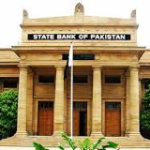 The pressure of trade and industry is mounting on State Bank of Pakistan (SBP) to curtail policy rate to bring down rate of inflation in the country. The basic premise is that country suffers from cost pushed inflation, which is also a key hurdle in boosting GDP growth rate and exports of the country. Some analysts are of the view that the current low international oil prices and expectations that these would hover below US$60/barrel in near future, offer an opportunity to SBP to seriously consider cutting policy rate. It has become all the more necessary as most of the central banks around the world are cutting down policy rate to avoid recession.
The pressure of trade and industry is mounting on State Bank of Pakistan (SBP) to curtail policy rate to bring down rate of inflation in the country. The basic premise is that country suffers from cost pushed inflation, which is also a key hurdle in boosting GDP growth rate and exports of the country. Some analysts are of the view that the current low international oil prices and expectations that these would hover below US$60/barrel in near future, offer an opportunity to SBP to seriously consider cutting policy rate. It has become all the more necessary as most of the central banks around the world are cutting down policy rate to avoid recession.
A series of attacks on tankers in or near the Strait of Hormuz and in the Red Sea, vessel seizures, and then the major strike on the key Saudi oil facility of Abqaiq failed to boost oil prices due to looming glut. OPEC production was down 1.6 million barrels per day (bpd) in September from August, the lowest level since November 2003, but the price of Brent crude hovered below US$60/barrel. A pertinent question arises; will the price remain at this level even after the beginning of winter? The probability is yes and demands SBP to also convince International Monetary Fund (IMF) to allow it to cut policy rate.
The IMF October World Economic Outlook confirms the subdued outlook. The world economy is now forecast to grow at 3.0% in 2019, 0.3% lower than the IMF’s earlier projection. There are few signs that the economic situation has hit rock bottom and is entering a recovery phase. Further downgrades are still possible.
The Fund noted that manufacturing activity has weakened substantially to levels not seen since the financial crisis of 2008, although the service sector remains relatively resilient. The OECD’s Composite Leading Indicator continues to deteriorate, reaching 99.06 in August.
The Fund sees growth of 3.4% in 2020 and a slightly higher growth rate for 2021-24 but notes major downturns in many large developing market economies. It is their recovery in 2020 and beyond which underpins stronger growth and also stronger oil demand as growth in four key areas, representing half of global GDP – China, the euro area, Japan and the US – is expected to remain subdued.
Subdued Demand
As a result of the weakening economic outlook, the US Energy Information Administration has cut its forecast for Brent to US$57/bbl in second-quarter 2020 as inventories are likely to rise in the first half of next year. Brent prices for second-half 2020 are forecast to hover around US$60. Again, this is a recovery-based scenario which does not show any substantial improvement in the global economy.
While lower oil prices are weighing on US shale oil drillers, and hitting the oil services sector hard, analysts expect output will take time to slow. The EIA estimates US crude production will still increase by 0.9 million bpd next year to an annual average of 13.2 million bpd.
The International Energy Agency, in its latest oil report, sees total non-OPEC production growing by 2.2 million bpd next year, driven by the US, Brazil and Norway, but has crimped its demand forecast for 2020 again by 100,000 bpd to 1.2 million bpd, reflecting slower global GDP growth.
Way Forward
To reverse this outlook, business confidence needs a shot and quickly. The only likely source of such a tonic is the US-China trade talks, which according to US President Donald Trump are going well and could produce a deal on the first phase of the overall negotiations by the middle of next month in time for the Asia-Pacific Economic Cooperation meetings scheduled in mid November in Chile.
The imposition of more tariffs has been avoided for now, but the Chinese description of the situation as ‘talking while fighting’ does not inspire confidence that a meaningful deal will be reached that can result in a rapid reduction in trade tensions. 15 months on and it seems a long road back to what might be termed pre-trade war normality.
Looming surplus
It is being said that surplus in first-half 2020 may continue and OPEC will have to address the issue when it meets in December this year. Further cuts to supply, underpinned by Saudi Arabia and non-OPEC member Russia, are likely to be needed to restore a semblance of market control by the producer group.
Saudi Arab is still pursuing plans for the partial floatation of its giant state oil company, Aramco. It will not want to curtail production in such circumstances, but a reassertion of OPEC’s market relevance may be the only way to boost confidence.
The gloom is likely to continue unless a combination of factors start influence the outlook, which include: real progress in the US-China trade talks and the lifting of some tariffs; an orderly Brexit or at least some reduction in uncertainty and further supply cuts by OPEC and other producers.